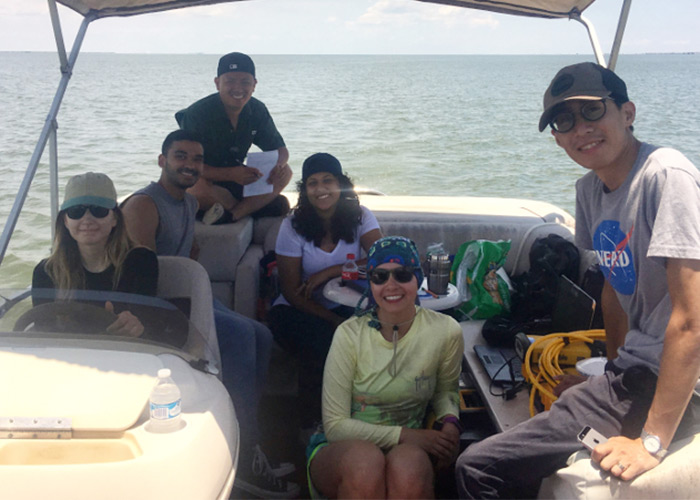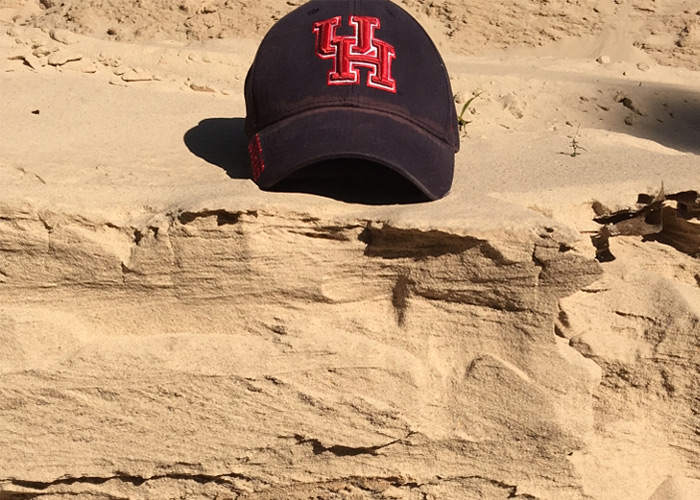UH Researchers Document Impact of Rain Water Surging into the Bay
The epic flooding from Hurricane Harvey has gotten most of the attention, but scientists say the impact of so much freshwater rushing into Galveston Bay – an estimated 34 trillion gallons fell along the Texas-Louisiana coast – may have a dramatic impact of its own.
 Students from the Department of Earth and Atmospheric Sciences spent part of August
collecting sediment and mapping the sea floor of Galveston Bay. That will provide
a useful comparison as they return to see what changes were wrought by Harvey.Researchers from the University of Houston will survey the sea bottom and collect
sediment samples, comparing their findings with the results of similar tests conducted
just weeks before Harvey came ashore.
Students from the Department of Earth and Atmospheric Sciences spent part of August
collecting sediment and mapping the sea floor of Galveston Bay. That will provide
a useful comparison as they return to see what changes were wrought by Harvey.Researchers from the University of Houston will survey the sea bottom and collect
sediment samples, comparing their findings with the results of similar tests conducted
just weeks before Harvey came ashore.
“We are trying to understand extreme event sedimentation patterns, which may or may not follow our assumptions,” said Will Sager, a geophysics professor in the UH College of Natural Sciences and Mathematics’ Department of Earth and Atmospheric Sciences. Sager is principal investigator for a $64,644 grant from the National Science Foundation to better understand how Harvey’s extraordinary rains affected sedimentation at tidal inlets on Galveston Bay. “We don’t know what we will find.”
But they have some ideas. Water flow volumes were so high and currents so strong that sand deposits were left along the banks of Houston's bayous, which the researchers say indicates large volumes of coarse sediment were mobilized by the storm, much of which likely ended up in Galveston Bay.
Sager is working with colleagues Rob Stewart, Hugh Roy and Lillie Cranz Cullen Distinguished University Chair in Exploration Geophysics, and Julia Wellner, an assistant professor in the department. Sager and Wellner will conduct the surveys and collect data; Stewart is director of the Allied Geophysical Lab at UH, which is assisting with logistics and analysis for both surveys.
 Currents were so strong in the aftermath of Harvey's epic flooding that massive sand
deposits were left along the banks of Buffalo Bayou and other area waterways.The project – part of a series funded by NSF in the wake of hurricanes Harvey, Irma
and Maria – will be compared with earlier work by the researchers and their students
to image the seafloor and collect sediment cores from Bolivar Roads and San Luis Pass,
the two natural inlets to the bay.
Currents were so strong in the aftermath of Harvey's epic flooding that massive sand
deposits were left along the banks of Buffalo Bayou and other area waterways.The project – part of a series funded by NSF in the wake of hurricanes Harvey, Irma
and Maria – will be compared with earlier work by the researchers and their students
to image the seafloor and collect sediment cores from Bolivar Roads and San Luis Pass,
the two natural inlets to the bay.
It was coincidence that the studies were done immediately prior to Harvey, but Wellner said the surveys provide the perfect opportunity to learn more about the impact of massive rainfall along the coast. Just weeks before the hurricane, UH scientists had completed geophysical sonar surveys of the inlets, producing high-resolution depth maps and acoustic images of the inlet floors, showing sediment types, thickness and vertical layering.
“We’re repeating the surveys as a way to see what the intense flood did to move sediment,” Wellner said.
In addition to the mapping, they will analyze samples in the lab to measure details of grain size, which she said reveals information about the velocity of the current.
The new insights gained from the planned research will be valuable not only for academic understanding of coastal sedimentation patterns during extreme rain events, but will also provide important information for state and federal agencies that administer the coast.
- Jeannie Kever, University Media Relations